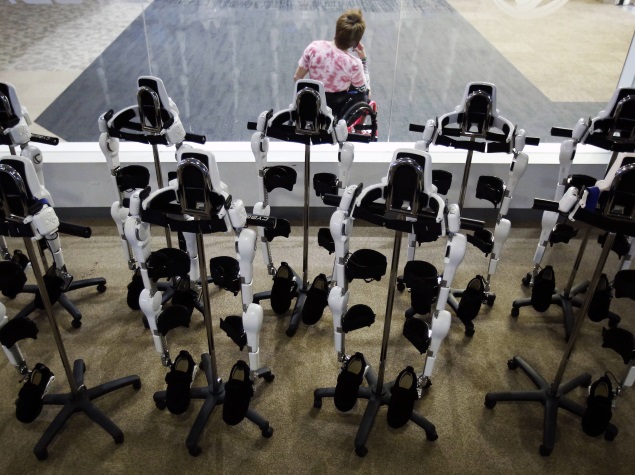Neurosurgeon Tetsuya Goto had just begun testing a robot to perform brain surgery when he discovered Japan was moving to tighten regulations that would shut down his seven-year project.

Over the next dozen years he watched in frustration as the da Vinci, a rival endoscopic robot that U.S. regulators had already approved, became a commercial success while his and other Japanese prototypes languished in laboratories.
Japan, with the world's largest robot population, is now awakening to a crisis as its lead in robotics - one of its last areas of technological prominence - comes under threat from better-coordinated efforts in the United States and Germany, as well as Asian rivals South Korea and China.
As robots advance from the factory floor into homes, hospitals, shops and even war zones, officials hope to spur a new "robotics revolution" by rewriting rules that researchers say have stifled innovation.
"We think robotics can make Japan competitive again," said Atsushi Mano, director of robotic technology at the trade ministry's New Energy and Industrial Technology Development Organization.
The agency has recruited Kawasaki Heavy Industries and Panasonic Corp to make a rival to the da Vinci that could perform more intricate tasks, such as removing pancreatic tumours, while a surgeon manipulates its controls.
At stake is a fast-growing industry - the market for industrial robotic systems is worth $29 billion (roughly Rs. 1,80,132 crores) a year worldwide according to the International Federation of Robotics.
Japanese Prime Minister Shinzo Abe said in June, when he unveiled a framework for sweeping regulatory reforms, that he expected Japan's robot market alone to triple to 2.4 trillion JPY (roughly Rs. 1,30,440 crores) by 2020.
Healthcare robotics is tiny now but has vast potential - such services are expected to overtake industrial uses within 10 years in the Japanese robot market.
The new surgical robot, part of a 5 billion yen medical robotics programme that aims to have products in clinical trials by 2019, should have an easier time than Goto faced with regulators.
"If you asked the authorities, they wouldn't say they kept medical devices from reaching the market, but as far as academics and companies are concerned they stopped Japanese research cold," said Goto, a professor at Shinshu University in central Japan.
Abe, who has called a snap election for next month to seek a renewed mandate for his "Abenomics" economic policies, has promised deregulation and structural reform to foster industrial growth as a two-year stimulus drive falters.
Rival robots
A key trigger to action was Google Inc's surprise acquisition a year ago of Schaft, a venture led by two former Tokyo University professors who developed a humanoid robot that handily won a rescue competition run by a research unit of the U.S. Department of Defense. The robot had to drive a utility vehicle and climb a ladder to prevail against more than a dozen rivals.
A key trigger to action was Google Inc's surprise acquisition a year ago of Schaft, a venture led by two former Tokyo University professors who developed a humanoid robot that handily won a rescue competition run by a research unit of the U.S. Department of Defense. The robot had to drive a utility vehicle and climb a ladder to prevail against more than a dozen rivals.
"Everyone associates bipedal robots with Japan so it was a shock that even that was being pulled away," said Waseda University Professor Masakatsu Fujie.
The U.S. robotics industry has been powered in large part by the military, which provides funding and field testing for drones and disaster-relief robots, while Silicon Valley has nurtured innovations in artificial intelligence and autonomous systems such as Google's self-driving car.
"To be honest, the U.S. is a concern," said Osamu Sudo, who helped to craft Japan's robotics strategy as director of the industrial machinery division at the trade ministry, where he served until early July.
Other countries are also pushing robotics to the forefront of industrial policy: China, where sales grew 32-fold over the last decade to eclipse Japan as the biggest robot market in 2013, aims to make one-third of its own robots by 2015..
South Korea has a five-year plan to spend $500 million (roughly Rs. 3,100 crores) a year on its robotics industry, while the European Union has earmarked 100 million euros ($125 million, roughly Rs. 776 crores) a year to its Horizon 2020 programme that aims to pull in a further 2 billion euros annually in private funding.

Japan is trying to keep up: ministries have requested 16 billion JPY ($138 million, roughly Rs. 857 crores) for direct investment in robotics in the next fiscal year.
But success will depend largely on reforming a fragmented regulatory process that can set insurmountable hurdles by mandating absolute safety, said Atsuo Takanishi, a professor at Waseda University specialising in robotics.
The trade ministry has convinced health ministry officials to relax certification procedures for medical devices and introduce affordable robots to nursing homes on a trial basis.
It also pushed for an international safety standard for care robots that Panasonic Corp cleared in February with a robotic nursing bed that folds up into a wheelchair, eliminating the need for care-givers to lift their patients.
With the freeing of regulations, Kiyoshi Sawaki, who recently replaced Sudo as head of the trade ministry's industrial machinery division, is confident that the government has created sufficient opportunities to succeed in robotics.
"The approval process is being simplified," he said. "So companies can't use the same excuses that they did before."

No comments :
Post a Comment